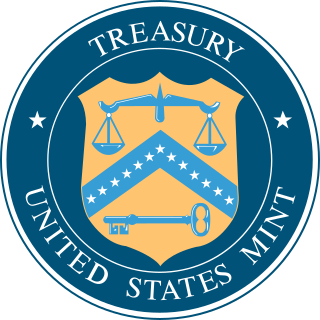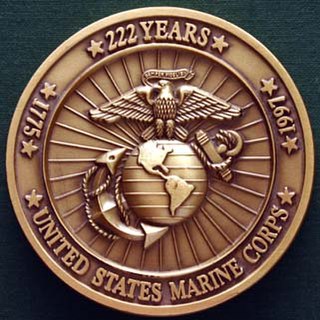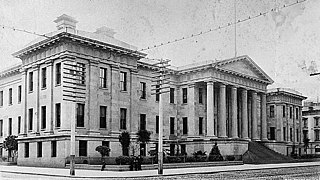External links
| This United States manufacturing company–related article is a stub. You can help Wikipedia by expanding it. |
Military Service Company, the oldest division of EBSCO Industries Inc, was founded during World War II and provides an array of goods and services that serve the U.S. military. The Birmingham, AL-based company's popular military commemoratives inventory includes challenge coins for the Army, Navy, Air Force, Marines, Coast Guard, Veterans, National Guard as well as military-themed license plate holders, pens and more.
In July 2009, Military Service Company's challenge coin business was purchased by Northwest Territorial Mint.
| This United States manufacturing company–related article is a stub. You can help Wikipedia by expanding it. |
Coin collecting is the collecting of coins or other forms of minted legal tender.

The Royal Mint is a government-owned mint that produces coins for the United Kingdom. Operating under the name Royal Mint Ltd, the mint is a limited company that is wholly owned by Her Majesty's Treasury and is under an exclusive contract to supply all the nation's coinage. As well as minting circulating coins for use domestically and internationally, the mint also produces planchets, commemorative coins, various types of medals and precious metal bullion. The mint exports to an average of 60 countries a year, making up 70% of its total sales. Formed over 1,100 years ago, the mint was historically part of a series of mints that became centralised to produce coins for the Kingdom of England, all of Great Britain and eventually most of the British Empire. The original London mint from which the Royal Mint is the successor was established in 886 AD and operated within the Tower of London for approximately 800 years before moving to what is now called Royal Mint Court where it remained until the 1960s. As Britain followed the rest of the world in decimalising its currency, the Mint moved from London to a new 38 acres (15 ha) plant in Llantrisant, Glamorgan, Wales, where it has remained since.

The United States Mint is a bureau of the Department of the Treasury responsible for producing coinage for the United States to conduct its trade and commerce, as well as controlling the movement of bullion. It does not produce paper money; that responsibility belongs to the Bureau of Engraving and Printing. The Mint was created in Philadelphia in 1792, and soon joined by other centers, whose coins were identified by their own mint marks. There are currently four active coin-producing mints: Philadelphia, Denver, San Francisco, and West Point.

The Royal Canadian Mint is a Crown corporation, operating under the Royal Canadian Mint Act. The shares of the Mint are held in trust for the Crown in right of Canada.

The Royal Australian Mint is the sole producer of all of Australia's circulating coins. Opened in 1965 and situated in the Australian federal capital city of Canberra, in the suburb of Deakin, the Mint is also a very popular tourist destination for visitors and locals alike.

The Reichsmark was the currency in Germany from 1924 until 20 June 1948 in West Germany, where it was replaced with the Deutsche Mark, and until 23 June in East Germany when it was replaced by the East German mark. The Reichsmark was subdivided into 100 Reichspfennig. The Mark is an ancient Germanic weight measure, traditionally a half pound, later used for several coins; whereas Reich, that is realm in English, comes from the official name for the German nation state from 1871 to 1943, Deutsches Reich.

A challenge coin may be a small coin or medallion, bearing an organization’s insignia or emblem and carried by the organization’s members. Traditionally, they might be given to prove membership when challenged and to enhance morale. In addition, they are also collected by service members and law enforcement personnel. Modern challenge coins are made in a variety of sizes and are often made using popular culture references to include superheroes and other well known characters in a way that creates a parody. Historically, challenge coins were presented by unit commanders in recognition of special achievement by a member of the unit. They are also exchanged in recognition of visits to an organization. Modern day challenge coins feature popular culture attributes.
The Freedom Tower Silver Dollar is a "one dollar" coin minted under license of the Commonwealth of the Northern Mariana Islands (CNMI) in 2004, although the CNMI does not have legal authority to issue or authorize currency. Despite vague statements in advertisements, it is not issued by the United States Mint and is not considered legal tender, nor is it considered non-circulating legal tender. The CNMI receives royalty fees from proceeds of the sale of the coin. The coin is actually minted by SoftSky, a Wyoming commemorative coin maker.

The United States Bullion Depository, often known as Fort Knox, is a fortified vault building located next to the United States Army post of Fort Knox, Kentucky. It is operated by the United States Department of the Treasury. The vault is used to store a large portion of the United States' gold reserves as well as other precious items belonging to or in custody of the federal government. It currently holds roughly 147 million troy ounces of gold bullion, over half of the Treasury's stored gold. The United States Mint Police protects the depository.

The Denver Mint is a branch of the United States Mint that struck its first coins on February 1, 1906. The mint is still operating and producing coins for circulation, as well as mint sets and commemorative coins. Coins produced at the Denver Mint bear a D mint mark. The Denver Mint is the single largest producer of coins in the world.

The Eisenhower Commemorative silver dollar is a United States commemorative coin minted in 1990 to celebrate the 100th Anniversary of the birth of General/President Dwight D. Eisenhower. This coin is not to be confused with the Eisenhower Dollar or the Eisenhower Presidential Dollar which were regular issue American coins.

The Sacagawea dollar is a United States dollar coin first minted in 2000, although not minted for general circulation from 2002 to 2008 and again from 2012 onward due to its general unpopularity with the public and low business demand for the coin. These coins have a copper core clad by manganese brass, giving them a distinctive golden color. The coin features an obverse by Glenna Goodacre. From 2000 to 2008, the reverse featured an eagle design by Thomas D. Rogers. Since 2009, the reverse of the Sacagawea dollar has been changed yearly, with each design in the series depicting a different aspect of Native American cultures. These coins are marketed as "Native American dollars".

The San Francisco Mint is a branch of the United States Mint and was opened in 1854 to serve the gold mines of the California Gold Rush. It quickly outgrew its first building and moved into a new one in 1874. This building, the Old United States Mint, also known affectionately as The Granite Lady, is one of the few that survived the great 1906 San Francisco earthquake. It served until 1937, when the present facility was opened.

The West Point Mint Facility is a U.S. Mint production and depository facility erected in 1937 near the U.S. Military Academy in West Point, New York, United States. Originally it was called the West Point Bullion Depository. At one point it had the highest concentration of silver of any U.S. mint facility, and for 12 years produced circulating pennies. It has since minted mostly commemorative coins and stored gold.
The Philadelphia Mint was created from the need to establish a national identity and the needs of commerce in the United States. This led the Founding Fathers of the United States to make an establishment of a continental national mint, a main priority after the ratification of the Constitution of the United States.
The Canadian Platinum Maple Leaf is the official bullion platinum coin of Canada. First issued by the Royal Canadian Mint in 1988, it was available until 2002 in five different denominations, all of which are marked as containing .9995 pure platinum. The bullion coin was partly reintroduced in 2009 in the form of the 1 troy ounce denomination in .9999 purity, featuring a new portrait of Queen Elizabeth II on the obverse. The coins have legal tender status in Canada, but as is often the case with bullion coins, the face values of these coins is lower than the market price of the material they are made from.

Medallic Art Company, Ltd. based in Dayton, Nevada is "America’s oldest and largest private mint" and specializes in making academic awards, maces, medallions, along with chains of office and universities medals for schools.

The America the Beautiful quarters are a series of 25-cent pieces (quarters) issued by the United States Mint starting in 2010 and scheduled to continue until 2021. The obverse (front) of all the coins depicts George Washington in a modified version of the portrait used for the original 1932 Washington quarter. There will be five new reverse (back) designs each year, each commemorating a national park or national site – one from each state, the federal district, and each territory. The program is authorized by the America’s Beautiful National Parks Quarter Dollar Coin Act of 2008.

The Wisconsin Territorial Centennial half dollar was designed by David Parsons and Benjamin Hawkins and minted in 1936. The obverse depicts a badger and the territorial seal, while the reverse shows a pick axe and lead ore.

The Women in Military Service for America Memorial silver dollar is a commemorative dollar issued by the United States Mint in 1994. It was one of three coins in the 1994 Veterans Program, along with the Vietnam War Memorial and Prisoners of War silver dollar.